How To Staet A Blog
If you're wondering how to start a blog in 2021 and make money online, this in-depth post can guide you through the setup process step by step so that you can have your new blog up and running in no time!

More than 8 years ago now, I decided to start a blog on a whim. I didn't really think much would come of it. (In fact, I was so nervous about putting it out there that I hoped no one would ever read it!) But what started as my little "secret project" has become my absolute dream job that my husband Donnie and I feel oh-so-blessed to be able to do full time. (Pinch me!)
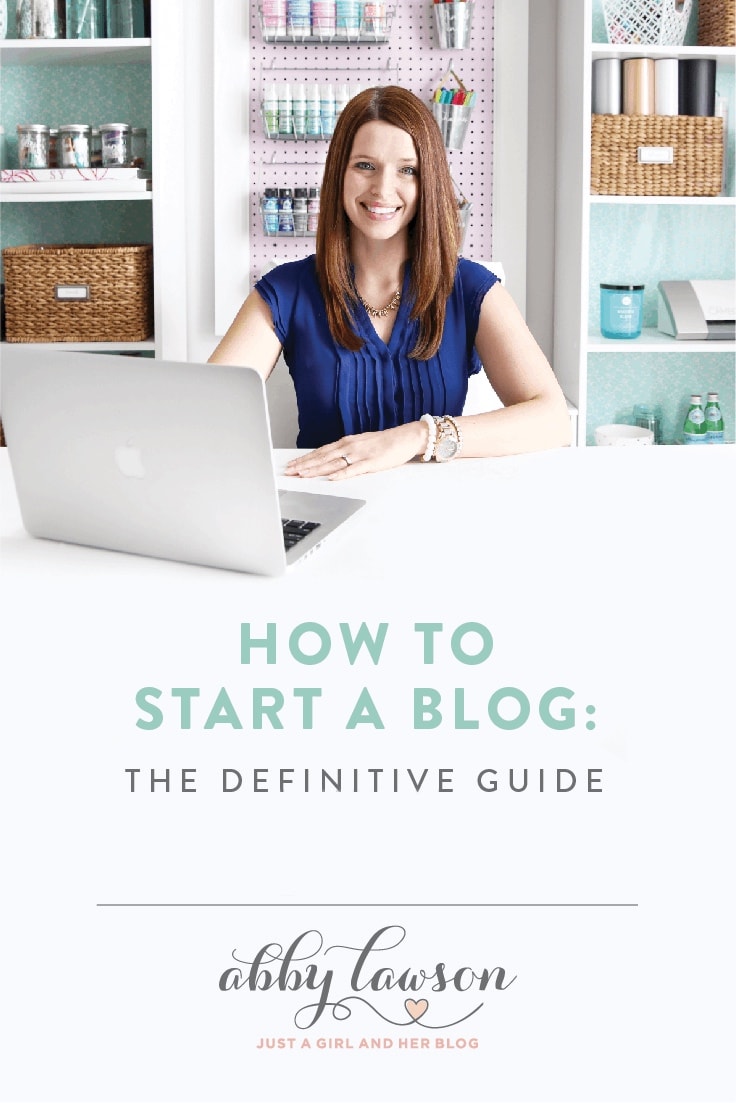

Over the years, one of the most common emails Abby and I have received is one asking us how to start a blog. It's something many people think about doing, but most of them simply don't know where to begin. Since we know that starting a blog has been a total game changer for our family, and Abby and I are passionate about helping others create blogs in hopes that they can become successful and change their own lives as well.
This page contains affiliate links meaning we earn a commission if you use those links. We only recommend brands we use and trust. See our disclosures.
This guide was created to show you how to start a blog in 2021. It's possible to have a blog up and running in just a few minutes, but we wanted to take things further and show you some of the important details behind starting a successful blog.
Things have changed over the years, and it's more important than ever to start your blog the correct way and lay a solid foundation for future blogging success. But please remember that the ultimate key to your blogging success is action. The most successful bloggers are the ones who do a whole lot more than they research.
I hope this extensive guide will help you. If you have something to share with the world and have always wanted to start a blog, you're in the right place.
I also want to take a minute and mention that we offer a blog setup service. It's not widely advertised because of the limited number of people we can help. If you're interested, please send an email to [email protected] and I'll provide more information.
For most people, the "do it yourself" method in this article is the way to go. Let's get started!
How to Start a Blog in 10 Easy Steps
Step 1: Pick a Blog Name
Step 2: Choose a Blog Host
Step 3: Customize Your Blog
Step 4: Protect Your Blog
Step 5: Add Standard Blog Pages
Step 6: Setup a Custom Blog Email Address
Step 7: Register Social Media Accounts
Step 8: Decide on a Blog Posting Schedule
Step 9: Promote Your Blog
Step 10: Make Money Blogging
Before we work through the steps of starting your blog, there are two questions I need to answer.
Why should you trust our blogging advice?
Great question. In January of 2013, my wife Abby started this blog. She worked like crazy during her first year, published new articles on a consistent basis, and connected with other bloggers, and as a result, the blog grew. In February of 2014 Abby asked me to join her (while still working my full time job) and help with the technical and strategic aspects of her blog. The blog grew some more. Then in January of 2015, I left my full-time job to help Abby with the blog on a full time basis. It's now 2021 and we are still going strong!
Now we receive over 500,000 page views every month and earn a multi six-figure income from the blog. We're not special, but we sure have learned a lot over the past few years. We've been where you are right now and have had the same questions you have. We're here to help you start your blog the right way.
Related: From Hobby Blog to Thriving Business: Our Blogging Story
Let's get started! Here are my detailed instructions (and advice) on how to start a blog in 10 easy steps...
Step 1: Pick a Blog Name
Before you pick a name for your blog and register the domain name (URL), there's something we have to talk about...
Can I start a blog for free? (Choosing the best blog platform)
You have an idea, a topic, or you just want a place to share your thoughts, but what is the best way to get started? Before we get into a discussion about which platform is best, it is important to note that a blog hosted on WordPress.com is a very different thing than a self-hosted blog on WordPress.org. Yes, the names look very similar, but the options and limitations that come with each one are very different, so be sure to note which one we're talking about as we discuss them below.
It's tempting to choose one of the numerous free blogging platforms like WordPress.com or Blogger-- everybody likes free, right?! But in this case, "free" definitely comes with some downsides. With both Blogger and WordPress.com blogs, you give up a tremendous amount of control and future flexibility by using a free blogging platform.
WordPress.com inhibits your ability to utilize display ads and various widgets, like those used for giveaways and link parties. Blogger is owned by Google, and therefore Google can shut down your blog any time they see fit. Blogger blogs can run ads, but they tend to earn less ad revenue than blogs of the same size that are self-hosted on WordPress.org. Some of these drawbacks may not seem like a big deal when you're first starting out, but they will definitely hinder your blog down the road, and switching platforms once your blog is established is not always an easy process.
If you think you'll be in this blogging thing for the long haul or would like to monetize your site at some point, we recommend starting with a self-hosted WordPress.org blog from the get-go. WordPress.org is the standard in the industry, and that's not likely to change anytime soon. The number of tools, themes, add-ons, e-commerce solutions, designs, and marketing software options that work with WordPress.org are endless, allowing you to create a site that looks exactly the way you want and has all of the functionality that you need.
Related: Should I Use WordPress or Squarespace for For My Blog?
Choose a blog name.
Choosing a domain name for your new blog can be a challenge. You want to choose something unique that reflects what your blog will be about and something you'll still love years down the road. When brainstorming domain names I like to use a simple free tool called Bust A Name. With Bust A Name, you can type in some keywords you're thinking of using, and it will come up with available combinations using those words. You can read about other domain picking tools in this Digital.com article.
When brainstorming a domain name, here are some best practices:
- Use a ".com" domain when possible. There are quite a few successful ".net" and ".co" blogs out there, but ".com" is more the standard for blogs, and it's easier for people to remember.
- Avoid numbers and hyphens in your domain name. Numbers confuse people because they never know if the number is spelled out when they hear the domain. The same is true for hyphens — it's hard for people to remember.
- Short and memorable is preferable over long and descriptive. I know it's tempting to try and use a bunch of words in your URL and explain exactly what your blog is about, but it's really not necessary.
- For many people, your name will make a great domain name.
Before making your final decision, it's a good idea to use a social media profile checker app like KnowEm. This will give you an idea about what social media profiles are available with a particular name. Most likely your preferred name won't be available on many social networks. Don't worry! You'll be able to create a profile with a slightly modified name.
A short story on domain research: When Abby decided on the URL of JustaGirlandHerBlog.com, she didn't do a whole lot of research. Many months after she started her blog she found another successful blogger in the same home decor/DIY niche with a similar blog name. Whoops! It hasn't caused too many issues, but I know Abby felt bad about it and reached out to the other site owner. Had she done a little more research, Abby probably would have decided on another name.
Note: If you still don't have that perfect URL or domain name in mind, no worries, you can still continue on and complete step two.
Step 2: Choose a Blog Host
In this step I will show you how to setup blog hosting and understand the WordPress (your blog control center!) dashboard.
This page contains affiliate links meaning we earn a commission if you use those links. We only recommend brands we use and trust. See our disclosures.
Purchase blog hosting and install WordPress.
It's time to purchase your blog hosting. Your new hosting company is where all the files and content associated with your blog will live. When readers type your new domain name into their browser, they will be shown content, articles, and pictures that are on servers owned by your hosting company.
A good hosting company is an important part of your new blog. Your host is where your blog "lives," where all of the important files for your blog are kept. If your host has problems, you have problems, so you'll want to make sure you choose a host that has fantastic service and helpful customer support.
I've written extensively about the hosting companies that I love and recommend, so be sure to pop over to that article if you'd like to weigh multiple options. My conclusion (from first hand experience) is that for most people, Bluehost is the perfect place to start.
Bluehost is one of the small handful of hosting companies that WordPress recommends, and at a cost of just $3.49/ per month (we actually have a special deal with Bluehost right now where you can get hosting for $2.75/month), it's just about impossible to beat their level of hosting, customer support, and uptime reliability for the same inexpensive price. And, if you cancel within 30 days, Bluehost will give you a full refund.
Register your domain name and create a blog hosting account. Click the button below to get a 65% discount with Bluehost, our favorite hosting provider for bloggers. The signup page will open in a new tab so you can continue with this tutorial.
Setting up Hosting at Bluehost
We're going to walk you through the steps of getting started with Bluehost. Don't be intimidated by the fact that there are 20 steps– that just means we've broken it down to make it really easy for you! Here we go!
1) Navigate to justagirlandherblog.com/bluehost. You'll be re-directed to Bluehost through our affiliate link, and you may get a few additional perks for signing up through our code. (Thank you for your support!) Click the big green "Get Started Now" button.

2) Choose the plan that's best for you. The basic plan should be fine for most people just starting out. If your blog grows you can always upgrade your plan without switching hosts.

3) You've already decided on a domain name at this point. To register your free domain name with Bluehost (this is a nice perk for new Bluehost accounts!), enter it under the "new domain" box and click "next." If you already have an existing domain name with another service, you can type it into the "I have a domain name" field.
Note: If you were unable to come up with a blog name and available URL in step one, don't worry! If you move your mouse cursor like you are leaving the page (don't actually leave!), a pop-up window should appear that says,"Can't decide on a domain name? Choose later." If you choose this option, Bluehost will add a credit to your account to choose your domain name at a later time.
4) Enter all of your account and contact information.
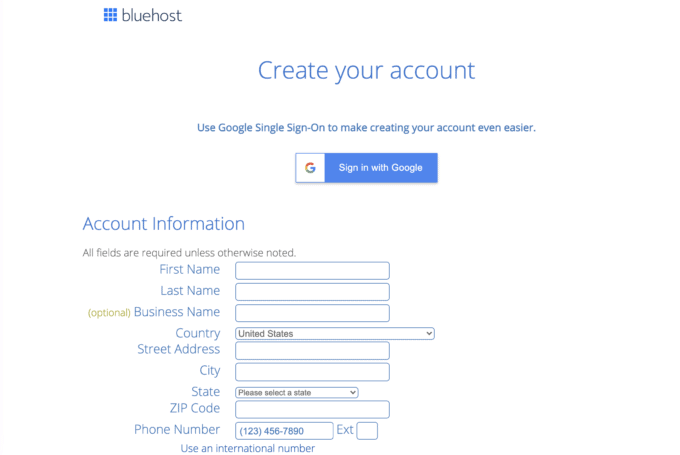
5) Continue down to the "package information" section. You get the cheapest monthly rate by selecting 36 months. It's important to note that Bluehost charges you for the full the 36 months up front. You are prepaying for the hosting. That's one of the reasons they are able to offer great hosting at such a small price. If you change your mind, you can cancel within 30 days for a full refund. If the upfront cost is too much, you could always consider pre-paying 12 months. If that's still too much and you're just not sure, take a look at our other hosting recommendations that don't require a pre-pay for the best deal.
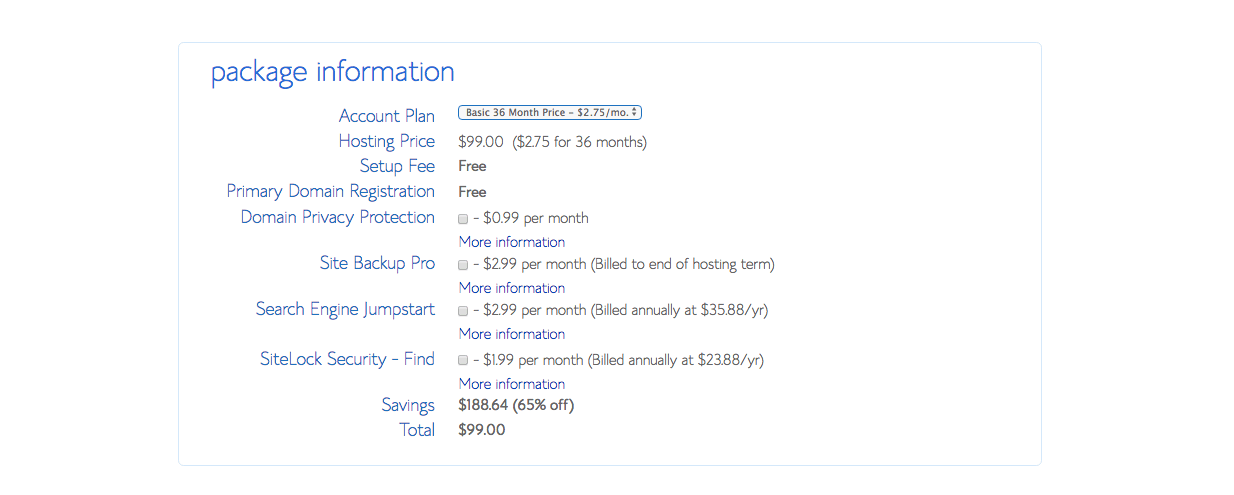
There are other services available on this screen. The only one I recommend is the "Domain Privacy Protection." This protects your personal information like name, address, and phone number from being publicly accessible.
If you decide later you want some of the other services, you can always have them added to your account.
We would recommend setting up some sort of backup system for your blog somewhere other than with your host so that you don't lose all of your hard work if your site would crash or your host would have a problem. When Abby first started, we backed her site up to Dropbox using a plugin called WordPress Backup to Dropbox. When we outgrew that, we moved to Vaultpress for a while and were pleased with them. Their packages start at $5 per month. But don't worry about this yet.
6) Enter your billing information, agree to the service agreements, and then click "submit."
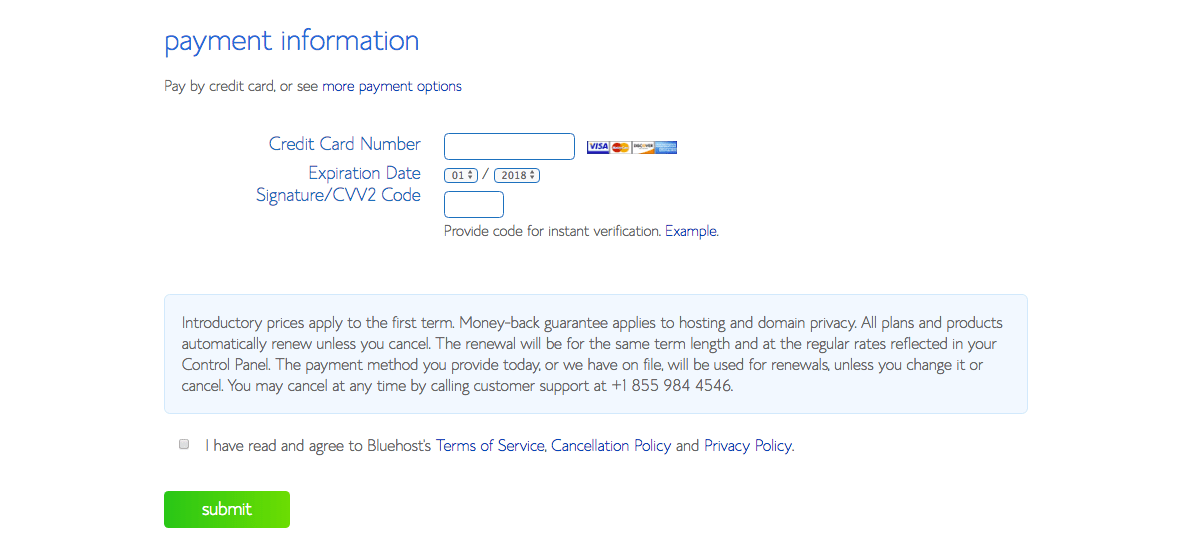
7) Again, there are some additional options you can purchase here, but I wouldn't. These could be added later if you need them. Click "no thanks."
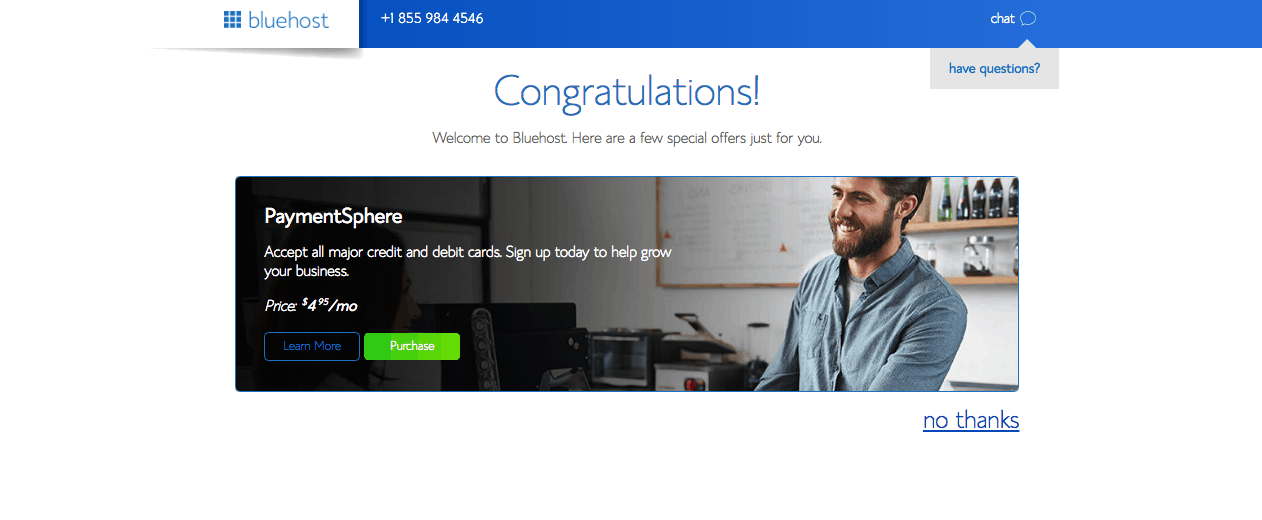
8) Congratulations! You officially have a Bluehost account. Next you need to create your password.
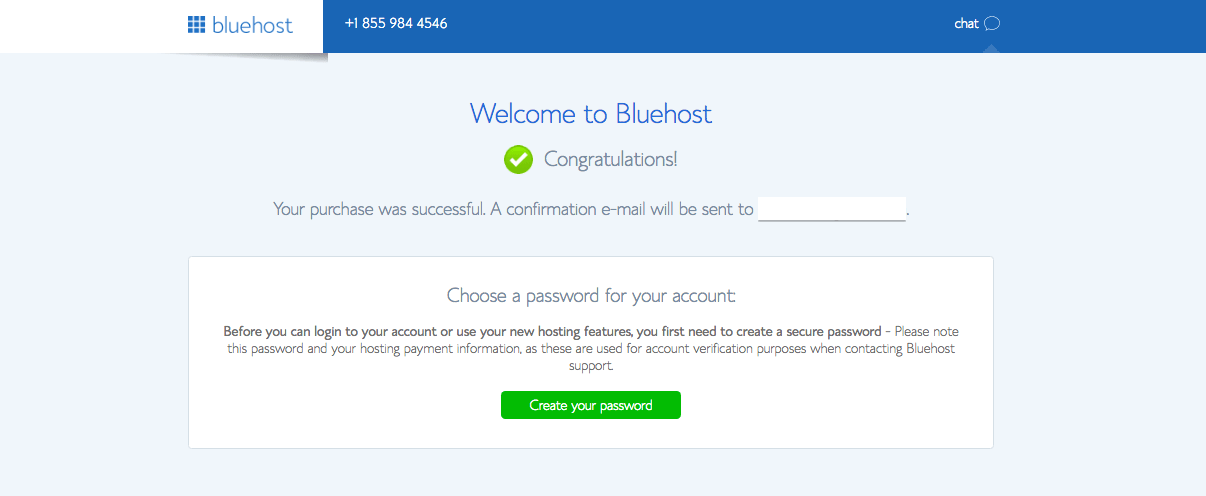
9) On this screen, you'll create your Bluehost account password. Don't forget it! (And of course make it a strong password so no one can hack your site!) Agree to the Privacy Policy and Terms of Service and then hit "Next."
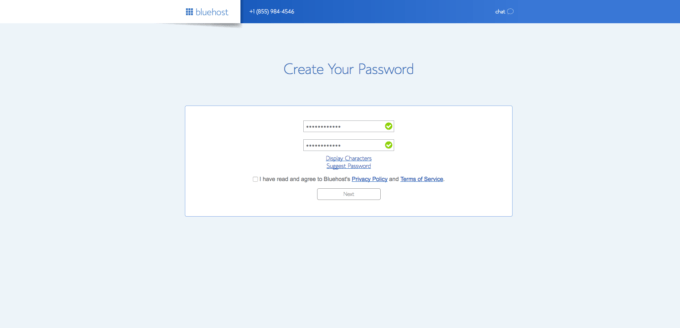
10) Now that your password has been created, you can log into your account for the first time! Click the blue "log in" button. It should automatically take you to the Bluehost Portal, but if not, go ahead and log in using the "hosting" tab and not "webmail."
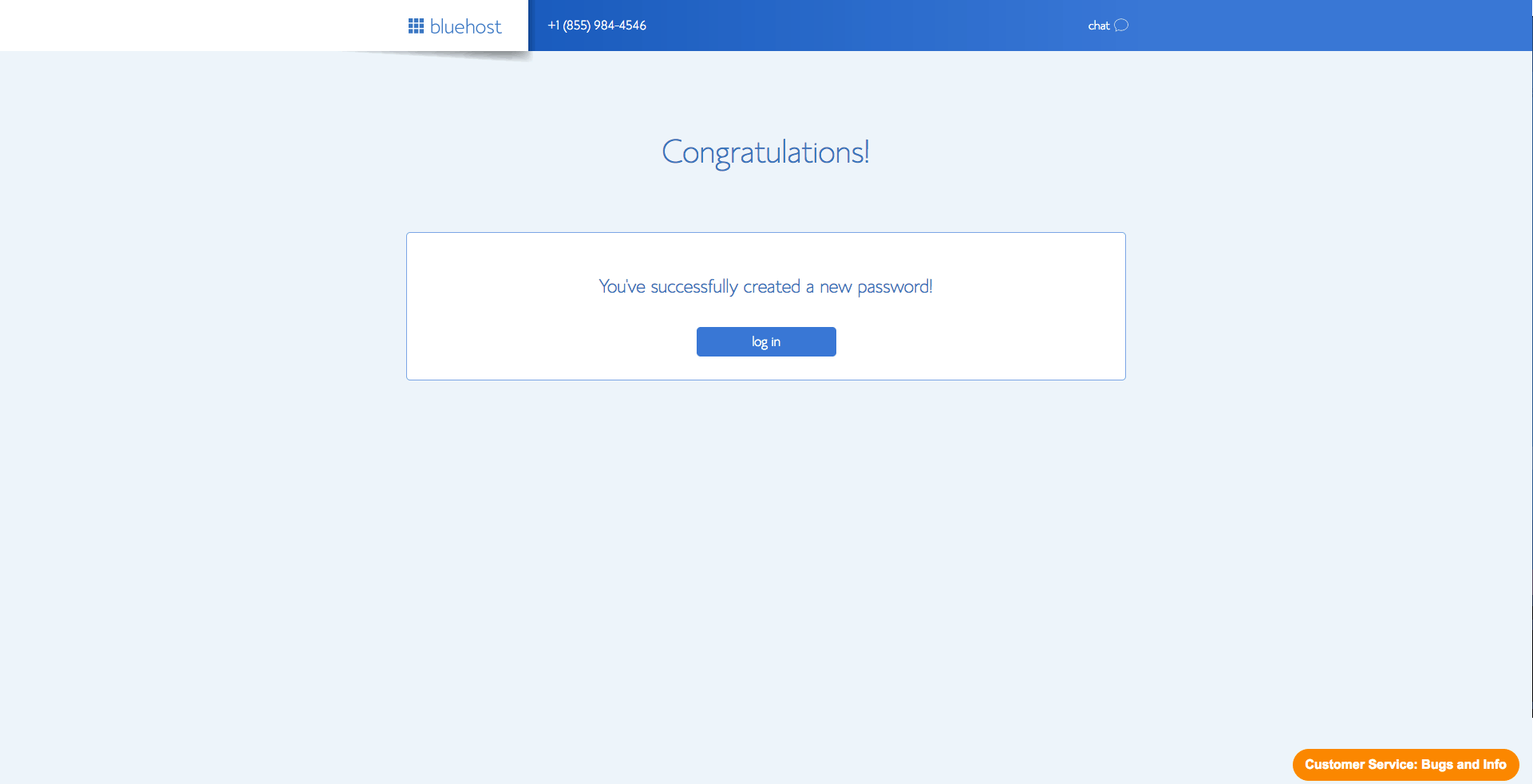
10) When your account opens for the first time, you'll have the option to choose a theme. You can do this later if you'd like so click "Skip This Step" below the offered themes.
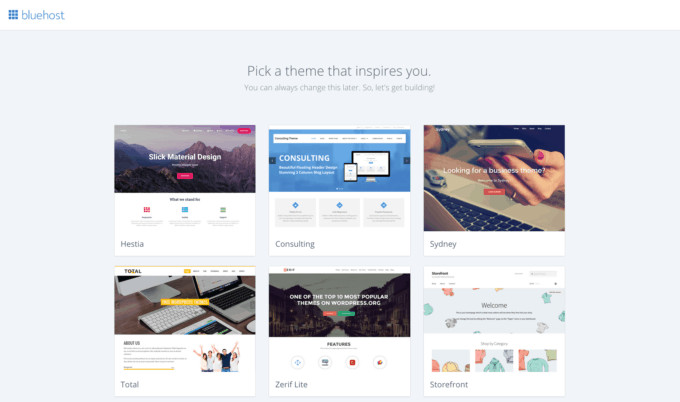
11) Bluehost will then install WordPress for you. You will see this screen when it finishes up.
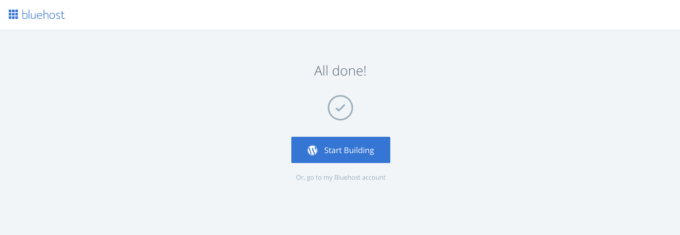
12) Go ahead and click the blue "Start Building" button. You will be brought to this screen.
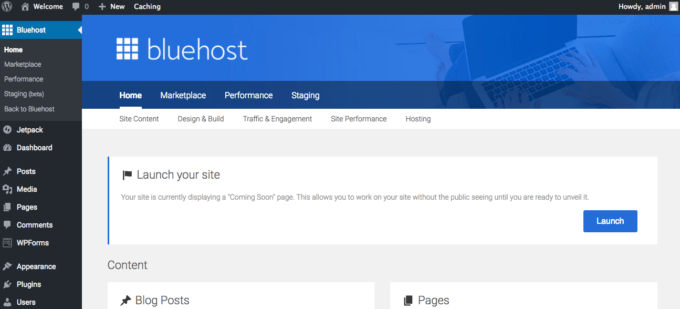
13) In the very bottom left corner of the screen you will see the word "Users". Hover your mouse over the word "Users" and select the option "Add New."
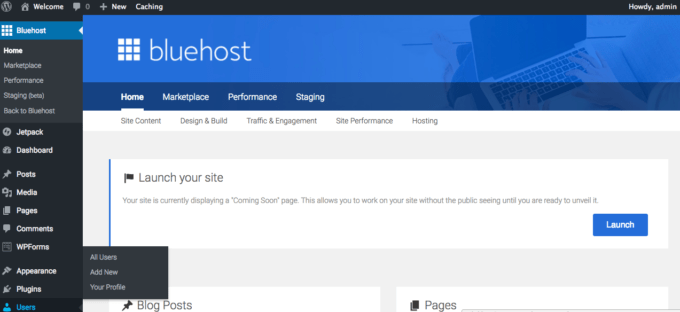
14) Fill out all the information on the next screen (Username, Email, etc) and be sure to change Role to "Administrator." You do NOT want to keep the Username "Admin" as it is not as secure.
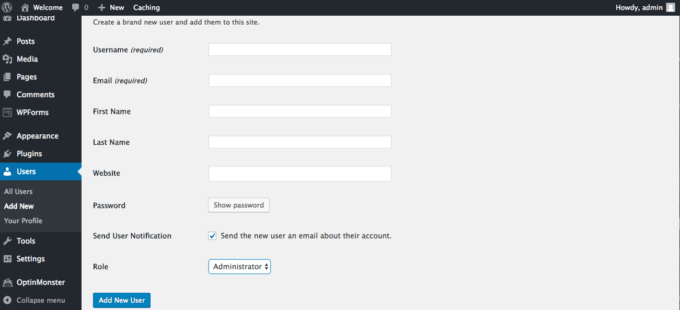
15) Click the "show password" button. Be sure to copy and paste and/or screenshot this and save it somewhere safe. You will need this password to log in to your WordPress site. You can always go back into your User Settings and change your password later. Once all the information is complete and you have your password, click the "Add New User" button at the bottom of your screen.
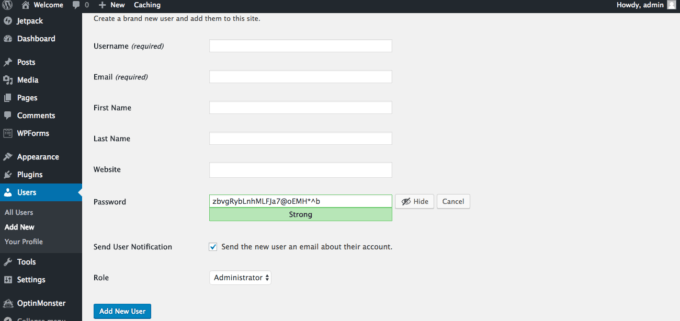
16) To log in to your WordPress site, go to http://yourURLhere.com/wp-login.php). It will take you to a login screen that looks like the one below. Enter your username and the password you just saved.
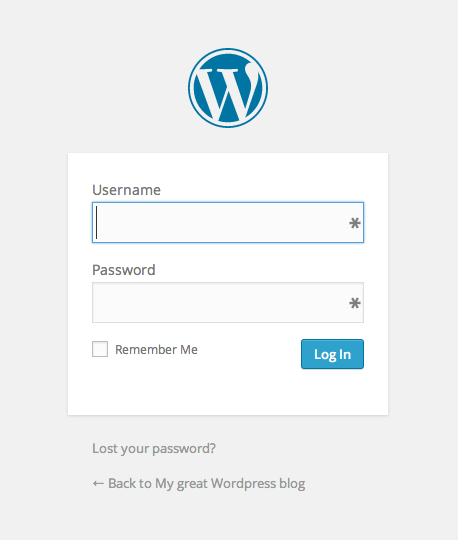
17) Now that you have logged in to WordPress, you'll be presented with your WordPress dashboard. You will learn to love this. Spend some time going through the various settings. It may be confusing at first, but in no time it will all be second nature.

If you haven't already, make sure you create your hosting account by clicking the button below! The signup page will open in a new tab.
You did it! Congratulations on choosing hosting, installing WordPress, and logging into your dashboard for the first time.
Note: Occasionally Bluehost changes the order or look of their setup screens. If you see a screen that doesn't look exactly like what you see above, don't worry, the process is still the same.
Understand the WordPress dashboard.
As you start to write and publish posts, you'll spend a lot of time in the WordPress dashboard. At first all of the settings and buttons may seem a bit intimidating, but after a few days or weeks you'll be a pro at navigating the interface. To get you started, I want to briefly point out a few important parts of the WordPress dashboard.
This is the home screen of the dashboard. You can customize this page by clicking on the "Screen Options" button in the upper right hand corner of the screen.
One of the first settings I recommend you change is the permalink structure. Click on "Settings" and then "Permalinks."
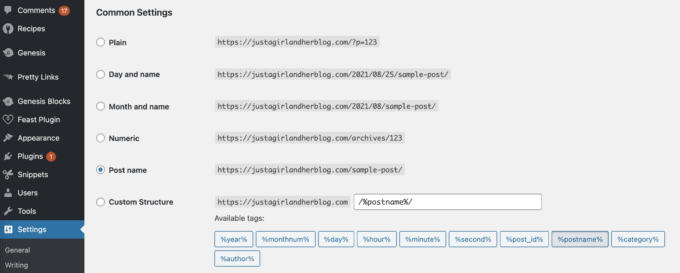
Then select the "Post Name" option. It's important to make this change before you start publishing posts. Once you publish and have inbound links to your posts, it's more complicated to change the URL structure.
Familiarize yourself with the "Plugins" section. We'll talk more about the essential plugins later in this article.
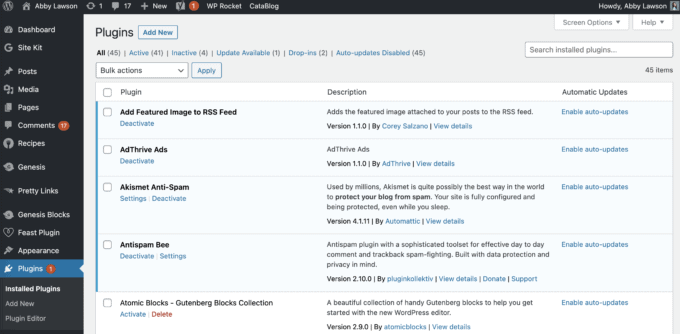
The "Posts" tab is where you compose and format your new blog posts.

The "Pages" tab is where you compose your static and permanent pages of your site like your "about page," and "disclosure" policy. With WordPress, the primary difference between posts and pages is that posts are dated articles and pages are undated. Posts will show up in your blog feed, and pages will not.
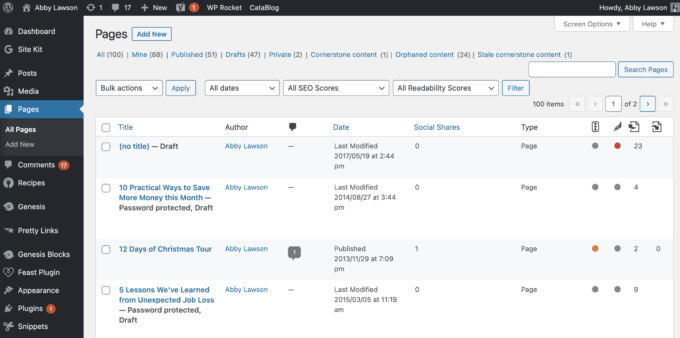
WordPress.tv has published a thorough walkthrough video of the WordPress dashboard. If you want the grand tour of the WP dashboard, you can take a few minutes and watch the video.
Step 3: Customize Your Blog
Next, we need to customize the look of your blog and add a few helpful features with WordPress plugins.
Choose a responsive WordPress theme.
Note: Genesis, my recommended WordPress theme framework is now free! Read more about Genesis below.
After blog hosting, the next money you spend on your blogging journey should be on a custom WordPress theme. There are thousands of free WordPress themes out there; WordPress even comes with the official 2021 theme pre-installed. As soon as you can swing it financially, though, I recommend you start with a premium theme that looks great out of the box with minimal customization. With more and more blogs starting every day, quality design is becoming increasingly important to blogging success, and a premium WordPress theme will help you get that professional look even as a new blogger.
If you do a little WordPress theme research, you'll find lots of articles and advice pointing back to the Genesis Framework. Genesis isn't a theme per se, but rather a theme framework that developers and designers can use as a base for their custom child themes.
Having a framework + child theme combination ensures that you won't lose your custom settings during site updates. When you have the Genesis Framework, you also have access to some really important plugins that are only available for sites running Genesis. Abby and I use the Genesis Framework + child theme strategy for all of our sites.
The first step is to purchase the Genesis Framework (now free!) directly from the creators at StudioPress. (It's easy to find pirated copies of Genesis floating around the internet and on Etsy, but we don't recommend it. There's no guarantee you'll get clean copy without malicious code embedded in the theme that can wreak havoc on your site in the future. The best option is to buy it straight from the source.) Upgrades are free forever. Once purchased, you can watch the video below to learn how to install the framework.
Now that you have Genesis installed, it's time to shop for a custom child theme. You can run the Genesis Framework by itself, but your site will look pretty plain and will not have any of the pretty elements and customizations you may have seen on other sites. Those elements are added by the child theme.
There are literally hundreds of theme stores out there advertising custom Genesis child themes. If you decide to buy a child theme on Etsy, be sure that the seller is extremely reputable and double and triple check on the type of support they offer. I've known bloggers who purchased beautiful looking child themes from relatively unknown designers on Etsy. Some of these child themes were poorly coded, and the developer provided little or no theme support. We always recommend purchasing from a known and trusted source like these:
1. StudioPress. If StudioPress (the creators of Genesis) is selling a child theme in their store, you can be sure that it's a well-coded and well-supported theme.
2. Restored 316. Lauren creates beautiful, well-coded feminine Genesis child themes. Abby used one of her designs for many years and was very pleased with the theme and the support Restored 316 provided.
3. Feast Design Co. Shay is the designer behind the incredibly popular and flexible Foodie Pro theme, a rock-solid theme with a lot of customization options. We currently use Shay's Brunch Pro theme for this site. Again, we have been thrilled with the quality of the theme and the support that Shay's team provides.
When you're deciding on a child theme, look closely at the layout and general structure of your theme. Colors can be changed, logos can be changed, and typography can be changed. It's harder to change the overall layout and structure of the theme.
Once you've purchased your child theme, you'll want to install it the same way you did the Genesis Framework - upload and install the zip file from your WordPress dashboard.
Install necessary WordPress plugins.
Now that you have your custom child theme, it's time to install a few important WordPress plugins. Plugins are great because they allow you to add certain features to your blog without having to mess with any code. On the negative side, though, the more plugins you have, the more potential issues (site speed, security, etc…) you may face. So while plugins provide a lot of great functionality to your blog, you'll only want to install the ones that you absolutely need. Here are a few that I use with every new blog setup:
1. Akismet. This is a plugin to reduce/eliminate spam comments.
2. Yoast SEO. The standard as far as a WordPress SEO plugin goes. It will help you easily structure your blog posts so that they rank high in search results.
3. W3 Total Cache. This is "caching" plugin that will speed up your site. The settings for this plugin are super complicated, so if you use this plugin, be sure to ask your host what settings they recommend rather than trying to configure it yourself.
4. Genesis eNews Extended. This is a handy little plugin that allows you to add an email signup form to any widget area on your site. This plugin is only for blogs using the Genesis Framework. The great thing about this plugin is that the signup form automatically pulls the styling from your child theme so everything matches. This plugin can be configured with most email marketing services like MailChimp and ConvertKit.
5. Genesis Simple Hooks. As you grow your blog you'll have the need to add various code snippets in different locations on your blog. For example, Google Analytics requires a tracking code and Pinterest verification requires some code. This plugin makes it easy to add bits of code (whether Javascript or HTML) to various places on your site without having access and edit your theme files directly. Genesis Simple Hooks will save you a lot of time. Again, this plugin is designed for use with the Genesis Framework.
6. Genesis Simple Share. A pretty and lightweight plugin that adds social sharing buttons to your posts and pages. Also designed to work with the Genesis Framework.
7. Pretty Link Lite. This is a plugin that allows you to make long and ugly links into pretty little links that re-direct to the final destination. This is particularly handy if you have a long affiliate link with lots of crazy characters at the end. You can use Pretty Like Lite to make links like justagirlandherblog.com/bluehost (pretty!) re-direct to the longer and not-so-pretty affiliate link.
You can search for and install all of these plugins directly from the "Plugins" tab within your WordPress dashboard.
Note: For a more extensive list of my favorite WordPress plugins, see this section of my blogging resources article.
Step 4: Protect Your Blog
In this step we will take care of some security and analytic related tasks. Please don't skip this step! Your future self will thank you.
Setup Google Analytics and Webmaster Tools
There are a couple of boring-but-necessary Google-related tasks that you need to take care of when you set up your blog. The first is creating a Google Analytics account.
Google Analytics is the industry standard for website and blog traffic reporting. It has the potential to give you some incredibly powerful insights into your blog traffic and site activity. I don't recommend you spend much time learning the ins and outs of Google Analytics when you first start blogging (you have more important things to do!), but it is necessary to create your account and start tracking your pageviews. Don't skip this — brands and potential advertising partners will routinely request your stats, and they'll want to see data specifically from Google Analytics.
If you have a custom email address with Google Apps, I recommend using that account with Google Analytics. If not, you can create a Google Analytics account with your Gmail login information.
Once you setup your free account, you'll receive some tracking code that you need to insert into your website. This is super easy, so don't worry! Because you have Genesis Simple Hooks installed, you can just paste the Google Analytics tracking code into the "genesis_after" section of your site. Click "save" and you're all set!
The second boring Google task you need to take care of is creating a Google Webmaster Tools account and adding your site. This will tell Google to start paying attention to the content you post on your site and over time may help you to rank in Google for specific search terms.
There's no need to mess around with all of the settings in webmaster tools, but you'll want add a sitemap to your account. A sitemap is an .xml file that makes it easy for Google to index your content. The best way to create a sitemap is from right inside the Yoast SEO plugin that you've already installed. Once your have the URL of your sitemap (ex: justagirlandherblog.com/sitemap_index.xml), you can add that URL to the sitemap section of your Google Webmaster tools account.
Pay attention to blog security.
New bloggers often overlook basic backup and site security needs. To be honest, Abby and I didn't pay much attention to this until several months into our blogging adventure. It's better to just take care of backup and site security at the start so that you don't have to worry about those "worst case scenarios."
Why You Need to Back Up Your WordPress Blog
Let's start with backup. It's absolutely critical to have a daily backup of your site. You may be thinking that it would be rare for your hosting servers to completely lose your site or for your blog to get deleted somehow. You're right, it is rare. What's more common is hacking attempts and malicious code infecting your site and all the thousands of various files. Your site isn't technically lost, but it might as well be if you don't have a backup or a good restore point.
This exact scenario happened to Abby and me — JustAGirlandHerBlog.com was somehow infected. Every single .php file associated with the site (thousands of files!) were somehow infected with malicious code. The site was throwing off all sorts of server errors, everything slowed to a crawl, and we were having a hard time even logging into WordPress. Our host scanned the site and revealed the malicious code infection.
At that point I had two options: 1) go through each file manually and remove the malicious code. This would have been a few weeks of full-time manual work. Who can afford that!?, or 2) Restore the site from a "clean" or "virus free" point.
Obviously we chose the second option. I downloaded a site backup file from a week prior and manually viewed the .php files. The files were clean and we were able to use the backup to restore the entire site.
If we didn't have a rock solid backup plan, our site might have been completely lost. I share this story to scare you. Don't think that it's almost impossible for your site to be completely lost. In our example, it wasn't deleted but rather infected. The need for a backup was the same.
When I talk to seasoned bloggers, just about all of them have a similar story of when they needed a backup. I've also talked to bloggers who threw in the towel after their site was infected and they had no backup. How sad! It's easily preventable!
There are number of good backup solutions out there. The current host for JustAGirlandHerBlog.com (Flywheel) has a built in feature where once-daily the entire site is automatically backed up. I can download (which I do about once per month) these backups at any time. I then store a copy of of this backup on a local Synology network attached storage device as well as a copy in one of my Google Drive accounts.
Flywheel has another neat feature where I can restore our site to one of our previous backup points with a single click. This feature is included with every Flywheel account.
If neither of those options work for you, I recommend you create a paid account with VaultPress.
Don't ignore WordPress security.
After the hacking incident mentioned above, I decided to invest in a CloudFlare account.
CloudFlare will improve your site in more ways than I can mention here, but one of their core functions is to improve site security. They pool the collective knowledge and analytics of all their customers to prevent automated hacking attempts and other malicious behavior that could wreck your site. You can learn more about CloudFlare security features in this article.
We pay $20/month for a pro CloudFlare account, but they also have a free account with nearly all of the same security features. I recommend you start with this free account from day one of your blog. I can say that since using CloudFlare we haven't had any substantial security issues with any of our sites.
More than security, CloudFlare can make your site blazing fast! You can read more about improving site speed in my article here.
Step 5: Add Standard Blog Pages
Before you start posting on a regular basis and before your official "launch," you need to create a few specific pages on your site. These are the pages that everyone expects to see when they visit your site. As a new blog, it's important to convey a sense of legitimacy and trust. These pages can help with that.
Disclosure, Privacy, and Comment Policy
If you ever want to earn money from your blog, you'll need some of these standard policies. In fact, Google requires them to be part of their Adsense program. Don't overthink it, but make sure you comply with the law. As an example, take a look at Abby's "disclosure" page here: justagirlandherblog.com/disclosure
An Amazing "About" or "About Me" Page
It's been proven over and over again that one of the most highly trafficked pages on your site by new visitors is your about page. People want to get to know you! They want to know the person behind the blog. Take some time to make this a fun, interesting, and engaging page on your site and then link directly to it on your menu.
For an example of an engaging about page, see Abby's and then read this article about creating a compelling about page from Lauren at The Thinking Closet.
Contact Page
You want your readers (and eventually other businesses) to have an easy way to contact you. I recommend that you setup a dedicated "contact" page, either with an embedded form or just simple instructions on how to get in touch with you. Take a look at Abby's contact page.
If you want to use an embeddable form for your "contact" page, consider using the free Typeform tool.
Step 6: Setup a Custom Blog Email Address
In this step you will learn how to setup a custom email address to match your business name as well as the best services for collecting email addresses and building your list.
Create a custom email address with Google Apps.
Email is an important but often overlooked part of your new blog. Pretty soon you'll want to email with other bloggers, brands, and companies, and it's important to have a professional dedicated email address.
There are two options:
The easiest solution is to create a free gmail account with your blog name. For example: [email protected]
That's not a bad solution and many people can survive for years without a truly custom email address. But remember, when you start collecting an email list and sending out emails, you may want to have a professional and custom address to match your name.
The second option is to create a custom email address that matches your domain. An example would be [email protected]
The great news is that you can have a custom email address and still use the familiar Gmail interface… it's called Google Apps for Business. I use it and love it! The only downside is that it's not a free option, but at $5/month it's well worth the money.
To get your custom email address, go to google.com/apps and start from there. It walks you through the setup process.
The only confusing part is verifying your domain and adding the MX records. My favorite method for verifying the domain is adding a text record to your DNS (Google will show you how). For us that means changing a few things in our CloudFlare account. For others that means logging into your hosting account and editing the DNS zone file. While you're in there, you'll also want to add some MX records to your DNS zone file.
It's not as hard as it sounds! Your domain registrar will likely have a tutorial already created to walk you through the process.
Related: How to Set Up a Custom Domain Email Address with Gmail
Start collecting email addresses.
One of the biggest blogging mistakes Abby and I made was not collecting email addresses sooner. It wasn't until a year after Abby started blogging that we got serious about growing an email list.
Why do I need an email list?
1. Traffic. Email is a very reliable way of driving traffic to your site. You can use email to inform new readers of your best old posts and encourage your subscribers to read your new posts. If you're able to get a reader's email address, you're much more likely to turn them from a one-time visitor into a regular and loyal reader. Pinterest and Google are both important sources for traffic, but they are sources you don't control. Your email list is yours.
2. Marketing. Email simply converts better than any other type of marketing (including social media). You may have no plans to sell something right now, but that day will eventually come and you'll be so thankful you have an email list.
Set up your email list.
Instead of the WordPress Jetpack plugin that has an email subscriber option, I recommend opening a MailChimp account (free up to your first 2,000 subscribers!) and integrating it with the Genesis eNews Extended plugin to create a subscribe form that automatically styles itself to match your blog's design.
If you have big plans for email or want to start immediately using email courses and automation series, I recommend you start with ConvertKit from the beginning with your new blog. ConvertKit has been described as "the power of Infusionsoft with the simplicity of MailChimp," and I wholeheartedly agree with that statement! Abby and I use and love ConvertKit.
An important principle to use when growing your email list is to offer your readers some type of incentive for handing over their email address. You want the offer to be so good and compelling that they can't resist! With millions of bloggers, website owners, and retailers vying for peoples' email addresses, "Join my free newsletter" is not a good enough incentive anymore. If you offer your readers something that will meet a need in their life or solve a problem for them, though, you will see your list grow quickly. Take a look at some of the posts on this site to get an idea of some of the forms and incentives we use on various posts and pages to get email subscribers. Those incentives have helped us grow our list to 150,000+ subscribers!
Step 7: Register Social Media Accounts
In the early days of your blog, social media can be a big distraction. I recommend that you focus on building up one or two social channels at a time before spending time growing a presence on something else.
Even if you don't have the time to focus on all of the social media channels at once, it's a good idea to get your names registered. I use a tool called Namechk to search and quickly find open usernames on the most popular social networks.
Note: For some of our favorite social media marketing tools and strategies, see our blogging tips article.
Step 8: Decide on a Blog Posting Schedule
If all of the other steps up to this point were of normal importance, this step is of extremely high importance! You simply won't have a successful blog if you're not spending at least 75% of your "blogging" time writing and posting high quality content, particularly when you're first getting started. This is crucial, but it's also the hardest part. It's hard to get into that creative mindset and write and publish even when you don't feel like it.
Publish great content on a regular schedule.
One of the things that made Abby successful as a blogger was her relentless posting schedule. She wrote even when she didn't feel like it. She made a schedule and never missed a post no matter what. It didn't matter if it was 10 PM and she hadn't started — she simply would not miss a post. If you want to be successful, you need the same attitude.
Let's talk about the ideal blog posting schedule.
When you first start your blog, you'll want to build up a library of posts fairly quickly so that readers have something to browse when they land on your site. Once you have 10-15 solid posts in place, it is a great time to develop a consistent posting schedule. I would say that being consistent with your posts is much more important than the number of times you post per week. When you are posting at the same days and times each week, you become part of your readers' routines and they come to expect your new posts, which makes it easier to build up a loyal following. The number of times per week you post is up to you. Think about how many high quality, helpful blog posts you can churn out on a consistent basis, and make that number work for you.
The high quality part is key! People are looking for posts that are helpful and relatable. Be sure to add tons of value for your readers in every post you write. That being said, don't be discouraged if your posts aren't as pretty or polished as you'd like them to be right from the start. Blogging is one of those things that takes practice-- bloggers get better over time!
If you have a moment, you should go back and look at the first posts of your favorite bloggers. Most likely they are terrible! The difference between successful bloggers and those that fail is that successful bloggers stick with it. They spend hours and hours honing their craft and getting a little better each day. They show up and continue pressing "publish" while learning from their numerous failures. We have to stick with it and keep learning and improving to have that kind of success.
So what makes a quality blog post that others will love reading and love sharing? There's a lot of nuance to that question, but here some thoughts:
What makes a quality blog post?
Be useful. It's fine to interject yourself and your story into your posts, but primarily you are writing for someone else. Is what you wrote helpful? Will what you wrote make someones life a little better?
Answer questions. Answer specific burning questions in your niche and give your perspective. You'll be seen as a helpful resource for your readers.
Long posts are great. I'm always disappointed when a Pinterest image or a post title catches my eye only to find out it's a 250 word post with no depth. It's ok to write long posts! Fluff isn't good, but if your message needs 2,000 words, that's ok! Don't be afraid of long posts.
Headlines are key. Plan to spend at least 20 uninterrupted minutes brainstorming headline and title ideas. People decide to click or not click on your posts primarily based on your headline. That being said, be careful not to fall into the trap of writing nothing but click-bait type articles with headlines that promise the world with content that doesn't deliver.
Great post images are necessary for social traffic. Spend time making eye-catching Pinterest-sized images for each post. You don't have to have Photoshop to do this! Look at free options like Canva and Pixlr. Original photography is great in certain niches, but you can also use free stock photos as the starting point for great post images. This Fizzle article has 50+ resources for finding free stock photography.
Tell stories. If it relates to the message you are trying to convey, share a personal story. If you do this, over time, your readers will feel like they know you. They'll have a personal connection to you and this will help you gain a loyal readership.
Create helpful resources. Think about the posts you've bookmarked and saved over the years… Chances are they were long guides or in-depth resources about a specific topic. Think about creating something like that in your niche. Think about the type of posts that readers will come back to over and over. These are the posts that just keep on getting traffic month after month.
Solve your readers' problems. Pay attention to what readers in your niche are struggling with. Notice what type of comments they are leaving on social media. Is there a common problem many of them face? Work hard to solve those problems and the traffic will come.
From the beginning I recommend that you keep a list of post ideas. You can do this in Evernote, a regular notebook, a Google Doc or spreadsheet, or anywhere else. If a post idea strikes you, take a minute to write down the idea. You want to have a bank of post ideas to turn to when you are not feeling creative.
Related: What Should I Blog About: 10 Ways to Discover Your Perfect Niche
Step 9: Promote Your Blog
As a new blogger, it's necessary to find a good balance between creating content and promoting content. In the early days it may look like 75% content creation and 25% content promotion. Over time as you build up a library of over 100+ posts, you may end up promoting your content close to 50% of the time.
Promote your content.
Remember that the best promotion strategy in the world won't get you significant traffic if the underlying content is not helpful and interesting. Promotion is great for getting eyeballs to your site, but great content is what will turn a casual visitor into a loyal reader.
Here are some effective promotion strategies that have worked for us. These strategies are particularly important in the early days of your blog.
1. Build relationships with other bloggers.
Make a list of 5-10 other bloggers who are a little more established than you are. Make a commitment to read their posts and provide helpful comments. You can't just say "great post!" and expect to get noticed. But over time, the blogger will notice you if you leave kind and helpful comments.
Along with reading and commenting, make a commitment to share their content on your social media accounts. Nothing says "thank you" like sharing a post on Facebook or Twitter. Over time, a few the bloggers on your list will start to notice you and may even promote a few of your posts to their audience.
During Abby's first year of blogging, she committed to commenting on 5 blogs per day, for a total of about 35 blogs per week. A lot of those bloggers are now some of her closest blog friends. She has guest posted for some bigger bloggers and was even a contributor for another blogger, simply because she took the time to consistently interact with bloggers she admired both on their blogs and on social media.
2. Join a community.
One of the best strategies for getting your name and your blog out there is by joining a Facebook or Slack group of like-minded bloggers. It takes some effort, but eventually you'll find your "tribe." These are bloggers that you resonate with and enjoy interacting with. Eventually you'll become friends with them, and when there is a collaboration opportunity they may ask you to join in.
Please keep in mind that the way to get noticed in these communities is by being as helpful as possible. Don't join a Facebook group and start posting links to all of your content. Instead, answer questions and join in the existing conversations. Posting links to your posts right away is like walking into a party and screaming, "Look at me! Look at me!"
Related: Why Blogging is Best Done in Community
3. Pinterest
For many bloggers, Pinterest is by far the largest source of traffic day in and day out. You'll want to set up a Pinterest account for your blog as soon as possible and start pinning high quality pins that are relevant to your blog's niche.
When Abby started growing her Pinterest following, she would go to accounts of bigger bloggers in her niche and check out a couple things. First, she would look at who they were following and who was following them, and she would follow those people too. Not everyone followed her back, but many did and her follower count started to grow.
While she was visiting the Pinterest profiles of bigger bloggers in her niche, Abby would also look at the group boards that they were a part of. Group boards allow you to get your posts in front of a larger audience than just your own, so you'll want to find several to join in your niche. When Abby found group boards in her niche (via other bloggers' profiles), she would click into them and there would usually be instructions for joining in the board description if they were accepting new pinners. She would request to join, and eventually she had a large number of group boards that she could use to share her content.
Understand SEO basics.
SEO (Search Engine Optimization) is an interesting topic. The idea is to highly optimize your posts so that they display near the top of Google search results for various keywords and phrases.
In my mind there is legitimate SEO and also non-legitimate SEO. The non-legitimate SEO tries to find loopholes in Google's search algorithm and then exploit those loopholes. Many times these strategies work for a while, but then Google catches on and updates their algorithm and Google penalizes sites that use these strategies.
Legitimate SEO strategies, on the other hand, are just best practices for post formatting, keyword usage, and headline tags. If you're focusing on creating quality content and writing easy-to-read posts that are helpful for people, SEO will fall into place. All of your SEO needs can be accomplished with the amazing and free Yoast SEO plugin for WordPress. Install it, understand it, and use it. That's it!
Step 10: Make Money Blogging
For the first few months you are blogging, your primary focus should be on creating amazing content and building relationships with other bloggers. Once you've settled into a routine and feel like you have this blogging thing under control, you can consider earning some money or "monetizing" your blog.
How to make money from your blog (monetize)
1. Ad Revenue
Use Google Adsense or other ad networks for display ads on your site. In order to earn significant income, your traffic numbers must be high.
2. Affiliate Links
Promote various products on your site and earn an income if a reader clicks on one of your links and makes a purchase.
3. Sponsored Posts
Team up with a company and get paid to promote their products. Typically you're paid on a "per post" basis as opposed to affiliate links, which require you to make a sale in order to get paid.
4. Digital Products
This is potentially the most lucrative income category. It's also the most time consuming to create and sell your own digital products. Digital products include eBooks, courses, printable, paid webinars, and email courses.
Abby and I have taken the "diversification" strategy when it comes to blog income. We started with Google Adsense, later added some affiliate links to the site, tried a few sponsored posts, and then eventually created our own products.
If you'd like to read more about blog monetization strategies or turning your blog into a business you can read our in depth article.
To see first hand the exact monetization strategies Abby and I use, you can read through some of our past income reports.
Conclusion

Whew! That was a lot! Starting a blog may seem fairly cut and dry from the outside, but when you get into it, there is a ton of work that goes into setting up, promoting, and running a blog. It's not impossible, though. Donnie and I are both completely normal people. Neither of us have degrees in business or marketing-- mine is in English and his is in political science. But we were both willing to jump in with both feet, learn as much as we could, and work harder than we've ever worked at anything in our lives. And today we get to do our dream jobs, working at home together while spending tons of time with our two little boys. That could be you someday too!
And make sure to visit our blogging tips page for more blogging articles, resources, and courses.
If you're still reading, you definitely deserve some sort of medal or something! 😉 Thank you so much for sticking with us. We absolutely cannot wait to see what you do with your blog-- go out there and get it!

This post contains affiliate links. For more information, see our disclosures here.
The images below are from a previous version of this article.

How To Staet A Blog
Source: https://justagirlandherblog.com/how-to-start-a-blog/
Posted by: gregoryleighte47.blogspot.com

0 Response to "How To Staet A Blog"
Post a Comment